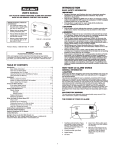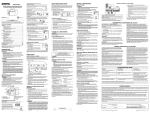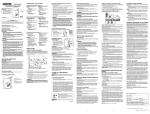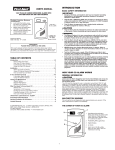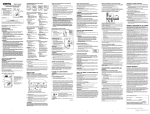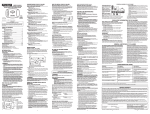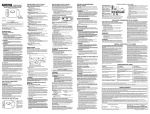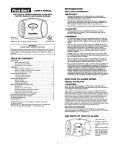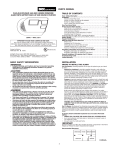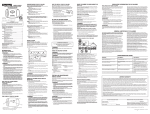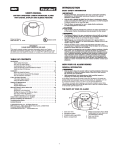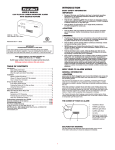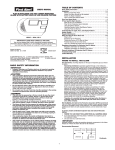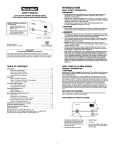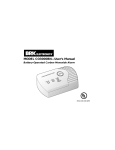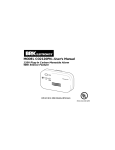Download BRK electronic FCD4 User's Manual
Transcript
INTRODUCTION
BASIC SAFETY INFORMATION
USER’S MANUAL
•
120V PLUG-IN CARBON MONOXIDE ALARM WITH BATTERY
BACK-UP AND REMOTE CONTROL TEST/SILENCE
•
Dangers, Warnings, and Cautions alert you to important operating
instructions or to potentially hazardous situations. Pay special
attention to these items.
THIS IS NOT A SMOKE ALARM! This CO Alarm is designed to detect
carbon monoxide from ANY source of combustion. It is NOT designed
to detect smoke, fire, or any other gas.
This CO Alarm is approved for use in single-family residences.
It is NOT designed for marine or RV use.
Reliable Protection, Maximum
Convenience!
• Just install the battery, plug
the alarm into a regular outlet,
test, and it’s ready to go!
•
•
Battery back-up keeps alarm
working if electricity fails.
•
This CO Alarm will only indicate the presence of carbon monoxide gas
at the sensor. Carbon monoxide gas may be present in other areas.
•
Test or silence the alarm with
a single push of most household remote controls.
•
•
Memory stores highest levels
of CO detected. Easy to display, easy to clear!
The Silence Feature is for your convenience only and will not correct
a CO problem. Always check your home for a potential problem after
any alarm. Failure to do so can result in injury or death.
This CO Alarm should receive continuous 120VAC, 60 Hz, pure sine
wave electrical power. (The battery is meant for emergency back-up
only). Do not use in an extension cord or outlet controlled by a dimmer or switch. In order for the emergency battery back-up to work, a
working (fresh) battery must be properly installed.
NEVER ignore your Carbon Monoxide Alarm if it alarms. Refer to
“If Your CO Alarm Sounds” for more information. Failure to do so can
result in injury or death.
Test the CO Alarm once a week. If the CO Alarm ever fails to test
correctly, have it replaced immediately! If the CO Alarm is not working
properly, it cannot alert you to a problem.
This product is intended for use in ordinary indoor locations of family
living units. It is not designed to measure CO levels in compliance
with Occupational Safety and Health Administration (OSHA) commercial or industrial standards. Individuals with medical conditions that
may make them more sensitive to carbon monoxide may consider
using warning devices which provide audible and visual signals for
carbon monoxide concentrations under 30 ppm. For additional information on carbon monoxide and your medical condition contact your
physician.
120V AC ~ 60 Hz 0.09A
M08-0018-001 P 03/03
•
Model FCD4
•
IMPORTANT!
PLEASE READ CAREFULLY AND SAVE.
This user’s manual contains important information about your Carbon
Monoxide (CO) Alarm’s operation. If you are installing this CO alarm for use
by others, you must leave this manual—or a copy of it—with the end user.
•
•
THIS USER’S MANUAL HAS BEEN RESIZED TO
PRINT OUT ON 8-1/2 x 11” PAGES.
BLACK page numbers reference the original printed document.
RED page numbers reference this web version.
TABLE OF CONTENTS
Introduction . . . . . . . . . . . . . . . . . . . . . . . . . . . . . . . . . . . . . . . . . . . . . . . . .1
Basic Safety Information . . . . . . . . . . . . . . . . . . . . . . . . . . . . . . . . . . . .1
How Your CO Alarm Works . . . . . . . . . . . . . . . . . . . . . . . . . . . . . . . . . .1
Understanding Your CO Alarm . . . . . . . . . . . . . . . . . . . . . . . . . . . . . . .2
Using the Remote Control Test/Silence Feature . . . . . . . . . . . . . . . . . .2
Using the Peak CO Memory . . . . . . . . . . . . . . . . . . . . . . . . . . . . . . . . .2
Installation . . . . . . . . . . . . . . . . . . . . . . . . . . . . . . . . . . . . . . . . . . . . . . . .2-3
Where to Install CO Alarms . . . . . . . . . . . . . . . . . . . . . . . . . . . . . . . .2-3
Where CO Alarms Should NOT Be Installed . . . . . . . . . . . . . . . . . . . . .3
How to Install Your CO Alarm . . . . . . . . . . . . . . . . . . . . . . . . . . . . . . . .3
If Your CO Alarm Sounds . . . . . . . . . . . . . . . . . . . . . . . . . . . . . . . . . . . . .3-4
If the Alarm Signal Sounds . . . . . . . . . . . . . . . . . . . . . . . . . . . . . . . . . .3
Using the Silence Features . . . . . . . . . . . . . . . . . . . . . . . . . . . . . . . . . .4
Testing and Maintenance . . . . . . . . . . . . . . . . . . . . . . . . . . . . . . . . . . . . . .4
Weekly Testing . . . . . . . . . . . . . . . . . . . . . . . . . . . . . . . . . . . . . . . . . . .4
Manually . . . . . . . . . . . . . . . . . . . . . . . . . . . . . . . . . . . . . . . . . . . .4
Remote Control . . . . . . . . . . . . . . . . . . . . . . . . . . . . . . . . . . . . . . .4
Regular Maintenance . . . . . . . . . . . . . . . . . . . . . . . . . . . . . . . . . . . . . .4
Replacing the Battery . . . . . . . . . . . . . . . . . . . . . . . . . . . . . . . . . . . . . .4
What You Need To Know About CO . . . . . . . . . . . . . . . . . . . . . . . . . . . . . .5
What is CO? . . . . . . . . . . . . . . . . . . . . . . . . . . . . . . . . . . . . . . . . . . . . .5
Symptoms of CO Poisoning . . . . . . . . . . . . . . . . . . . . . . . . . . . . . . . . .5
Finding the Source of CO After an Alarm . . . . . . . . . . . . . . . . . . . . . . .5
Potential Sources of CO in the Home . . . . . . . . . . . . . . . . . . . . . . . . . .5
How Can I Protect My Family? . . . . . . . . . . . . . . . . . . . . . . . . . . . . . . .5
Underwriters Laboratories Inc. UL2034 . . . . . . . . . . . . . . . . . . . . . . . . .5-6
Frequently Asked Questions . . . . . . . . . . . . . . . . . . . . . . . . . . . . . . . . . . .6
General Limitations Of CO Alarms . . . . . . . . . . . . . . . . . . . . . . . . . . . . . .6
Limited Warranty . . . . . . . . . . . . . . . . . . . . . . . . . . . . . . . . . . . . . . . . . . . .6
All Rights Reserved. © 2003 BRK Brands, Inc.
BRK Brands, Inc., 3901 Liberty Street Road, Aurora, IL 60504-8122
Consumer Affairs: (800) 323-9005 • www.firstalert.com
HOW YOUR CO ALARM WORKS
GENERAL INFORMATION
Leave your CO Alarm plugged in year-round. CO problems can occur any
time during the year, and this Alarm can only alert you if it is plugged in
and receiving power.
This CO Alarm is intended for use in a standard, unswitched 120V AC wall
outlet. It is not intended for use in extension cords, power strips, or outlets
controlled by a switch or dimmer. These may not provide continuous power to
the unit. When fully powered, the unit samples the air and takes a new reading
about every second. A microchip inside the unit stores each reading, and
remembers the levels of CO it has been exposed to over time. The Alarm
sounds when it has been exposed to a “critical” level of CO (measured in
parts per million or “ppm”) within a specified time (measured in minutes). This
CO Alarm features a permanently installed sensor, an indicator light, and an
85 dB alarm horn. It also has a Silence Feature to temporarily quiet the alarm
horn.
MALFUNCTION WARNING
This unit performs self-diagnostic tests approximately every second. If the
Alarm malfunctions, replace it immediately.
THE COVER OF YOUR CO ALARM
3
6
2
1
5
4
1
1
Test/Silence/Scroll Button: Press
and release to select mode (Test,
Memory, Clear Memory); Press
and hold to activate mode, or to
silence the alarm.
2
POWER/ALARM Light (Red)
3
Digital Display
4
Air Vents
5
Alarm Horn: 85db audible alarm
for test, alarm, and unit malfunction warning.
6
Remote Control Target: Aim an
IR remote control at the front of
the Alarm to Test or Silence.
(Works with most IR remote
controls.)
UNDERSTANDING YOUR CO ALARM
USING THE REMOTE CONTROL TEST/SILENCE FEATURE
BASIC POWER CONDITIONS
Using the VOLUME or CHANNEL buttons on most remote controls, you can
test or silence this CO Alarm from up to 12 feet (3.6 meters) away.
To Test or Silence the Alarm:
1. Make sure you have a clear path between you
and the Alarm, free of any obstructions.
2. Point the remote at the front of the Alarm.
Alarm operating
on AC power
Alarm operating
on emergency
battery back-up
Low / missing
battery warning
3. Press the VOLUME or CHANNEL button for at
least 2 seconds.
“Err” Alarm is
not operating
properly
If the Alarm does not respond to your
remote control:
• You may be standing too far away.
• Your remote may not be compatible.
• The feature may be accidentally disabled*.
• You did not hold the button on your remote for at least 2 seconds.
• The remote Silence Feature only works once in an alarm situation. Using
the Test/Silence button on the CO Alarm will still silence the unit. The
remote Silence Feature will return when the unit clears itself.
What you see and hear during installation
WHEN YOU FIRST INSTALL THE
BATTERY:
UNDER NORMAL CONDITIONS
(AC POWER):
HORN: Chirps briefly
HORN: Silent
DISPLAY: Flashes “888” briefly;
switches to “bat” after a minute
DISPLAY: Dash remains lit at
“READY”
POWER/ALARM Light: Flashes
once a minute
POWER/ALARM LIGHT: Shines
continuously
WHEN YOU FIRST PLUG-IN
THE CO ALARM:
HORN: Silent
HORN: Sounds loudly - 4 beeps,
pause, 4 beeps, pause
DISPLAY: Dash appears by
“READY”
DISPLAY: Flashes “888” briefly
POWER/ALARM LIGHT:
Shines continuously
*NOTE: The remote control option will be disabled if you hold down the
Test/Silence/Scroll button while installing the battery. If you accidentally disable
the remote option, remove the battery and re-install it, making sure you are not
touching the Test/Silence/Scroll button.
WHEN YOU TEST THE CO ALARM:
USING THE PEAK CO MEMORY
The CO Memory Feature lets you check the highest level of CO recorded
during an alarm.
To check CO Memory:
1. Press and release the Test/Silence/Scroll button until the dash scrolls
to “MEMORY”.
2. Press and hold Test/Silence/Scroll button to display Memory CO level.
To clear CO Memory:
1. Press and release the Test/Silence/Scroll button until the dash scrolls to
“CLEAR MEMORY.”
2. Press and hold the Test/Silence/Scroll button until the display shows “CLr.”
NOTE: The highest CO level will be saved, even after a power interruption,
until you clear it. DO NOT clear the CO Memory reading if you plan to call
someone to investigate a CO problem! Clear the CO Memory reading only
after the investigator has checked your home.
POWER/ALARM LIGHT:
Flashes rapidly
What you see and hear under different conditions:
DURING A POWER FAILURE
(IN BATTERY BACK-UP):
IF BATTERY BECOMES LOW
OR IS MISSING:
HORN: Silent
HORN: Chirps once a minute*
DISPLAY: Displays the word
“bat” continuously
DISPLAY: The word “bat” flashes
on and off
POWER/ALARM LIGHT: Flashes
once a minute.
POWER/ALARM LIGHT: Flashes
once a minute
WHEN THE ELECTRICITY COMES
BACK ON:
HORN: Silent
DISPLAY: Dash appears by
“READY”
POWER/ALARM LIGHT: Shines
continuously.
IF THE CO ALARM IS NOT
OPERATING PROPERLY:
INSTALLATION
WHERE TO INSTALL CO ALARMS
HORN: Three rapid chirps
every minute
The National Fire Protection Association (NFPA) recommends that a CO Alarm
should be centrally located outside of each separate sleeping area in the
immediate vicinity of the bedrooms. For added protection, install additional
CO Alarms in each separate bedroom, and on every level of your home.
DISPLAY: Displays “Err”
POWER/ALARM LIGHT: Flashes
three times in sync with the horn.
If your bedroom hallway is longer than 40 feet (12 meters), install a CO Alarm
at BOTH ends of the hallway.
What you see and hear if CO is detected:
PRE-ALARM LEVELS:
HORN: Silent
DISPLAY: Shows CO levels
detected in ppm
POWER/ALARM LIGHT:
On continuously
ALARM LEVELS OF CO ARE
DETECTED:
HORN: Sounds loudly - 4 beeps,
pause, 4 beeps, pause.
This sequence repeats for as
long as the unit is in alarm*
DISPLAY: Shows CO levels
detected in ppm
POWER/ALARM LIGHT:
Flashes rapidly
*Note: If unit goes into alarm
under battery back-up power,
the regular 4 beeps-brief pause
cycle will repeat for four minutes.
After four minutes, the pause will
increase to 1 minute.
IF YOU SILENCE THE ALARM:
HORN: Silent for about
4 minutes*
DISPLAY: Shows CO levels
detected in ppm
POWER/ALARM LIGHT:
Flashes rapidly
BEDROOM
BEDROOM
*Note: After 4 minutes, if CO levels drop below alarm levels, the
unit will remain silent and return
to normal operation. If CO presence still indicates a potentially
dangerous situation, the horn will
sound again.
KITCHEN
LIVING ROOM
HALL
BEDROOM
GARAGE
BASEMENT
IF THE CO LEVELS RETURN
TO NORMAL:
REQUIRED TO MEET NFPA RECOMMENDATIONS
HORN: Silent
SUGGESTED AREAS FOR INSTALLING ADDITIONAL CO ALARMS
DISPLAY: Dash lit by “READY”
Continued...
POWER/ALARM LIGHT:
Shines continuously
2
Where to Install CO Alarms, Continued
In a Single-level Home:
• Install at least one CO Alarm near or within each separate sleeping area.
• For added protection, install an additional CO Alarm at least 20 feet
(6 meters) away from the furnace or fuel burning heat source.
PLUG THE ALARM INTO AN OUTLET
In a Multi-level Home:
• Install at least one CO Alarm near or within each separate sleeping area.
• For added protection, install at least one CO Alarm on each level of the
home. If you have a basement, install that CO Alarm at the top of the
basement stairs.
• For added protection, install an additional CO Alarm at least 20 feet
(6 meters) away from the furnace or fuel burning heat source.
1. Plug the unit into a standard UNSWITCHED 120V AC outlet. The unit
should be located where it can wake you if it alarms at night.
This CO Alarm should receive continuous electrical power. The battery is
meant for emergency back-up only. Do not plug this Alarm into an outlet
controlled by a dimmer or switch.
2. Make sure the POWER/ALARM light shines continuously when you
plug it in.
3. Test by pressing the Test/Silence/Scroll button firmly until the unit sounds:
4 beeps, pause, 4 beeps. During testing, the POWER/ALARM light will
flash and “888” will appear briefly on the Display. This is normal.
This unit should receive continuous electrical power. (The battery is
meant for emergency back-up only). Choose an outlet where it can’t be
accidentally unplugged or switched off by children. Keep small children
away from the unit. Teach them not to play with it or unplug it. Explain
what the alarms mean.
PREPARE YOUR ALARM LABELS
Find the pair of self-adhesive labels included with this CO Alarm.
WHERE CO ALARMS SHOULD NOT BE INSTALLED
DO NOT locate this CO Alarm:
• In a location where it could be easily triggered when using your remote to
operate your TV, VCR, etc.
• In garages, kitchens, furnace rooms, or in any extremely dusty, dirty
or greasy areas.
• Closer than 15 feet (4.6 meters) from a furnace or other fuel burning heat
source, or fuel burning appliances like a water heater.
• Within 5 feet (1.5 meters) of any cooking appliance.
• In extremely humid areas. This Alarm should be at least 10 feet (3 meters)
from a bath or shower, sauna, humidifier, vaporizer, dishwasher, laundry
room, utility room or other source of high humidity.
• In areas where temperature is colder than 40˚F (4˚C) or hotter than 100˚F
(38˚C). These areas include non-airconditioned crawl spaces, unfinished
attics, uninsulated or poorly insulated ceilings, porches, and garages.
• In turbulent air, like near ceiling fans, heat vents, air conditioners,
fresh air returns, or open windows. Blowing air may prevent CO from
reaching the sensors.
• In direct sunlight.
• In outlets covered by curtains or other obstruction.
•
This CO Alarm is designed for use inside a single-family home or
apartment. It is not meant to be used in common lobbies, hallways, or
basements of multi-family buildings unless working CO Alarms are
also installed in each family living unit. CO Alarms in common areas
may not be heard from inside individual family living units.
•
This CO Alarm alone is not a suitable substitute for complete
detection systems in places which house many people, like hotels or
dormitories, unless a CO Alarm is also placed in each unit.
•
DO NOT use this CO Alarm in warehouses, industrial or commercial
buildings, special-purpose non-residential buildings, RVs, boats,
or airplanes. This CO Alarm is specifically designed for residential
use, and may not provide adequate protection in non-residential
applications.
•
On each label write in the phone number of your emergency responder
(like 911) and a qualified appliance technician.
•
Place one label near the CO Alarm, and the other label in the “fresh air”
location you plan to go if the alarm sounds.
NOTE: A qualified appliance technician is defined as “a person, firm, corporation, or company that either in person or through a representative, is engaged
in and responsible for the installation, testing, servicing, or replacement of
heating, ventilation, air conditioning (HVAC) equipment, combustion appliances and equipment, and/or gas fireplaces or other decorative combustion
equipment.”
IF YOUR CO ALARM SOUNDS
Actuation of your CO Alarm indicates the presence of carbon monoxide
(CO) which can kill you. When your CO Alarm sounds, you must not
ignore it!
IF THE ALARM SIGNAL SOUNDS:
1. Operate the Test/Silence button.
2. Call your emergency services, fire department or 911. Write down the
number of your local emergency service here:
__________________________________________________________________
3. Immediately move to fresh air—outdoors or by an open door or window.
Do a head count to check that all persons are accounted for. Do not reenter the premises, or move away from the open door or window until the
emergency services responder has arrived, the premises have been aired
out, and your CO Alarm remains in its normal condition.
4. After following steps 1-3, if your CO Alarm reactivates within a 24-hour
period, repeat steps 1-3 and call a qualified appliance technician to investigate for sources of CO from fuel-burning equipment and appliances, and
inspect for proper operation of this equipment. If problems are identified
during this inspection have the equipment serviced immediately. Note any
combustion equipment not inspected by the technician, and consult the
manufacturers’ instructions, or contact the manufacturers directly, for
more information about CO safety and this equipment. Make sure that
motor vehicles are not, and have not, been operating in an attached
garage or adjacent to the residence. Write down the number of a qualified
appliance technician here:
HOW TO INSTALL YOUR CO ALARM
_________________________________________________________________
IMPORTANT! Read all instructions before using this product.
“ALARM-MOVE TO FRESH AIR”
Quick reference:
•
Install the 9V battery to activate
the battery back-up.
•
Plug the Alarm into a standard
120V unswitched outlet.
•
Test the CO Alarm.
If you hear the alarm horn and the red light is
flashing, move everyone to a source of fresh air.
DO NOT unplug the CO Alarm!
Alarms have various limitations. See "General Limitations of CO Alarms"
for details.
ACTIVATE THE BATTERY BACK-UP
Continued...
1. Open the battery compartment on the back
of the Alarm.
2. Connect the battery to the battery contacts,
making sure it cannot shake loose.
3. Close the battery compartment completely.
The battery back-up is designed to provide
emergency power to the CO Alarm for 7 days.
Actual back-up time depends on the strength
(freshness) of the battery. The battery back-up
will not work unless a good battery is properly
installed.
3
USING THE SILENCE FEATURES
REPLACING THE BATTERY
The Silence Feature is intended to temporarily silence your CO Alarm’s horn
while you correct the problem—it will not correct a CO problem. While the
alarm is silenced, it will continue to monitor the air for CO.
Choosing a Replacement Battery:
This unit requires one standard 9V alkaline battery. The following alkaline
batteries are acceptable as replacements: Duracell #MN1604 or MX1604;
Eveready “Energizer” 522. You can also use an Ultralife 9 volt lithium battery
#U9VL for longer service life between battery changes. These replacement
batteries are commonly available at local retail stores.
To Activate the Silence Feature Manually:
Press and hold the Test/Silence/Scroll button until the horn is silent.
To Activate the Silence Feature Using Your Remote Control:
Standing no farther than 12 feet (3.5 meters) away, point your remote control
at the cover of the CO Alarm and push the VOLUME or CHANNEL button.
Hold the button down for at least 2 seconds.
Use only the alkaline or lithium replacement batteries listed. The unit may not
operate properly with other batteries. Never use rechargeable batteries since
they may not provide a constant charge.
Once you activate the Silence Feature: the Silence cycle will last
approximately 4 minutes.
To Replace The Battery:
NOTE: The remote Silence Feature only works once in an alarm situation.
Using the Test/Silence button on the CO Alarm will still silence the unit. The
remote Silence Feature will return when the unit clears itself.
•
If CO levels drop below alarm levels after 4 minutes, the unit will return to
normal operation and remain silent.
•
If CO levels do not drop below alarm levels, the unit will alarm again.
The Silence Feature is for your convenience only and will not correct a
CO problem. Always check your home for a potential problem after any
alarm. Failure to do so can result in injury or death.
NEVER disconnect your CO Alarm to silence the horn. Use the Silence
Feature. Unplugging the CO Alarm and removing the batteries removes
your protection!
1. Open the battery compartment.
SILENCING THE LOW BATTERY WARNING
2. Use the thumb guide to remove the old battery.
This silence feature can temporarily quiet the low battery warning “chirp” for
up to 8 hours without having to remove the battery. You can silence the low
battery warning “chirp” two ways:
3. Insert the new battery, making sure it snaps completely into the battery
terminals and cannot be shaken loose.
1. Manually: Press the Test/Silence button on the alarm cover.
4. Close the battery compartment, then test the battery back-up by pressing
the Test/Silence/Scroll button.
2. Using Your Remote Control: Standing no further than 20 feet (6 meters)
away from the CO Alarm, aim your IR remote at the CO Alarm and press
the CHANNEL or VOLUME button for at least 3-5 seconds.
5. Plug the CO Alarm back into the outlet.
Once the low battery warning “chirp” silence feature is activated, the unit continues to flash the red light once a minute for 8 hours; the word “bat” will flash
on and off on the display. After 8 hours, the low battery “chirp” will resume.
Replace the battery as soon as possible, this unit will not operate without
battery power!
DO NOT spray cleaning chemicals or insect sprays directly on or near
the CO Alarm. DO NOT paint over the CO Alarm. Doing so may cause
permanent damage.
To deactivate this feature: Press the Test/Silence button or use your remote
control again. The unit will go into Test Mode and the low battery warning will
resume (LED flashes and unit sounds “chirp” once a minute.)
Household cleaners, aerosol chemicals and other contaminants can affect the
sensor. When using any of these materials near the CO Alarm, make sure the
room is well ventilated.
If you cannot silence the low battery warning, replace your battery
immediately.
If your home is being fumigated, unplug the unit temporarily and put it where
it will not be exposed to chemicals or fumes. When fumigation is complete
and all traces of fumes clear, plug the unit back in and retest it.
TESTING AND MAINTENANCE
WEEKLY TESTING
You can test this CO Alarm two ways:
1. Manually: Press the Test/Silence/Scroll button on
the Alarm cover until alarm sounds.
2. Remote Control: Aim your remote control at
the CO Alarm and press the CHANNEL or
VOLUME button.
During testing, you will hear a loud alarm sequence –
4 beeps, pause, 4 beeps, pause.
•
If the Alarm ever fails to test properly, replace it immediately.
Products under warranty may be returned to the manufacturer for
replacement. See “Limited Warranty” at the end of this manual.
•
DO NOT stand close to the Alarm when the horn is sounding.
Exposure at close range may be harmful to your hearing. When
testing, step away when horn starts sounding.
•
The two methods described on this page are the only proper ways to
test the CO Alarm. NEVER use vehicle exhaust! Exhaust may cause
permanent damage and voids your warranty.
REGULAR MAINTENANCE
To keep the CO Alarm working properly:
•
Test it every week as described in “Weekly Testing.”
•
Vacuum the CO Alarm cover at least once a month, using the soft brush
attachment. Never use water, cleaners, or solvents, since they may damage the unit. Test the Alarm again after vacuuming.
•
Replace the battery immediately when you see/hear the
“Low Battery Warning”.
The Low (or Missing) Battery Warning:
The horn will “chirp” once a minute and the word “bat”
will flash on and off on the display.
4
WHAT YOU NEED TO KNOW ABOUT CO
The following conditions can result in transient CO situations:
WHAT IS CO?
1. Excessive spillage or reverse venting of fuel appliances caused by outdoor
conditions such as:
• Wind direction and/or velocity, including high, gusty winds. Heavy air in
the vent pipes (cold/humid air with extended periods between cycles).
• Negative pressure differential resulting from the use of exhaust fans.
• Several appliances running at the same time competing for limited
fresh air.
• Vent pipe connections vibrating loose from clothes dryers, furnaces, or
water heaters.
• Obstructions in or unconventional vent pipe designs which can amplify
the above situations.
2. Extended operation of unvented fuel burning devices (range, oven, fireplace).
3. Temperature inversions, which can trap exhaust close to the ground.
4. Car idling in an open or closed attached garage, or near a home.
These conditions are dangerous because they can trap exhaust in your
home. Since these conditions can come and go, they are also hard to recreate
during a CO investigation.
CO is an invisible, odorless, tasteless gas produced when fossil fuels do not
burn completely, or are exposed to heat (usually fire). Electrical appliances
typically do not produce CO.
These fuels include: Wood, coal, charcoal, oil, natural gas, gasoline,
kerosene, and propane.
Common appliances are often sources of CO. If they are not properly maintained, are improperly ventilated, or malfunction, CO levels can rise quickly.
CO is a real danger now that homes are more energy efficient. “Air-tight”
homes with added insulation, sealed windows, and other weatherproofing can
“trap” CO inside.
SYMPTOMS OF CO POISONING
These symptoms are related to CO POISONING and should be discussed
with ALL household members.
Mild Exposure:
Slight headache, nausea, vomiting, fatigue (“flu-like” symptoms).
Medium Exposure:
Throbbing headache, drowsiness, confusion, fast heart rate.
Extreme Exposure:
Convulsions, unconsciousness, heart and lung failure. Exposure to carbon
monoxide can cause brain damage, death.
HOW CAN I PROTECT MY FAMILY?
A CO Alarm is an excellent means of protection. It monitors the air and
sounds a loud alarm before Carbon Monoxide levels become threatening for
average, healthy adults.
A CO Alarm is not a substitute for proper maintenance of home appliances.
To help prevent CO problems and reduce the risk of CO poisoning:
• Clean chimneys and flues yearly. Keep them free of debris, leaves, and
nests for proper air flow. Also, have a professional check for rust and corrosion, cracks, or separations. These conditions can prevent proper air
movement and cause backdrafting. Never “cap” or cover a chimney in
any way that would block air flow.
• Test and maintain all fuel-burning equipment annually. Many local gas or
oil companies and HVAC companies offer appliance inspections for a
nominal fee.
• Make regular visual inspections of all fuel-burning appliances. Check appliances for excessive rust and scaling. Also check the flame on the burner
and pilot lights. The flame should be blue. A yellow flame means fuel is not
being burned completely and CO may be present. Keep the blower door on
the furnace closed. Use vents or fans when they are available on all fuelburning appliances. Make sure appliances are vented to the outside. Do not
grill or barbecue indoors, or in garages or on screen porches.
• Check for exhaust backflow from CO sources. Check the draft hood
on an operating furnace for a backdraft. Look for cracks on furnace
heat exchangers.
• Check the house or garage on the other side of shared wall.
• Keep windows and doors open slightly. If you suspect that CO is escaping
into your home, open a window or a door. Opening windows and doors
can significantly decrease CO levels.
In addition, familiarize yourself with all enclosed materials. Read this
manual in its entirety, and make sure you understand what to do if your
CO Alarm sounds.
This CO Alarm measures exposure to CO over time. It alarms if CO levels are
extremely high in a short period of time, or if CO levels reach a certain minimum over a long period of time. The CO Alarm generally sounds an alarm
before the onset of symptoms in average, healthy adults. Why is this important? Because you need to be warned of a potential CO problem while you
can still react in time. In many reported cases of CO exposure, victims may be
aware that they are not feeling well, but become disoriented and can no
longer react well enough to exit the building or get help. Also, young children
and pets may be the first affected. The average healthy adult might not feel
any symptoms when the CO Alarm sounds. However, people with cardiac or
respiratory problems, infants, unborn babies, pregnant mothers, or elderly
people can be more quickly and severely affected by CO. If you experience
even mild symptoms of CO poisoning, consult your doctor immediately!
FINDING THE SOURCE OF CO AFTER AN ALARM
Carbon monoxide is an odorless, invisible gas, which often makes it difficult
to locate the source of CO after an alarm. These are a few of the factors that
can make it difficult to locate sources of CO:
• House well ventilated before the investigator arrives.
• Problem caused by “backdrafting.”
• Transient CO problem caused by special circumstances.
Because CO may dissipate by the time an investigator arrives, it may be difficult to locate the source of CO. BRK Brands, Inc. shall not be obligated to
pay for any carbon monoxide investigation or service call.
POTENTIAL SOURCES OF CO IN THE HOME
UNDERWRITERS LABORATORIES INC.
UL2034
WHAT LEVELS OF CO CAUSE AN ALARM?
Underwriters Laboratories Inc. Standard UL2034 requires residential CO
Alarms to sound when exposed to levels of CO and exposure times as
described below. They are measured in parts per million (ppm) of CO over
time (in minutes).
UL2034 Required Alarm Points*:
• If the alarm is exposed to 400 ppm of CO, IT MUST ALARM BETWEEN
4 and 15 MINUTES
• If the alarm is exposed to 150 ppm of CO, IT MUST ALARM BETWEEN
10 and 50 MINUTES.
• If the alarm is exposed to 70 ppm of CO, IT MUST ALARM BETWEEN
60 and 240 MINUTES.
* Approximately 10% COHb exposure at levels of 15% to 95% Relative
Humidity (RH).
The unit is designed not to alarm when exposed to a constant level
of 30 ppm for 30 days.
Fuel-burning appliances like: portable heater, gas or wood burning fireplace,
gas kitchen range or cooktop, gas clothes dryer.
Damaged or insufficient venting: corroded or disconnected water heater
vent pipe, leaking chimney pipe or flue, or cracked heat exchanger, blocked or
clogged chimney opening.
Improper use of appliance/device: operating a barbecue grill or vehicle in an
enclosed area (like a garage or screened porch).
Transient CO Problems: “transient” or on-again-off-again CO problems can
be caused by outdoor conditions and other special circumstances.
CO Alarms are designed to alarm before there is an immediate life threat.
Since you cannot see or smell CO, never assume it’s not present.
•
An exposure to 100 ppm of CO for 20 minutes may not affect average,
healthy adults, but after 4 hours the same level may cause headaches.
•
An exposure to 400 ppm of CO may cause headaches in average, healthy
adults after 35 minutes, but can cause death after 2 hours.
Continued...
5
GENERAL LIMITATIONS OF CO ALARMS
UL2034 Information Continued...
Standards: Underwriters Laboratories Inc. Single and Multiple Station carbon
monoxide alarms UL2034.
According to Underwriters Laboratories Inc. UL2034, Section 1-1.2: “Carbon
monoxide alarms covered by these requirements are intended to respond to
the presence of carbon monoxide from sources such as, but not limited to,
exhaust from internal-combustion engines, abnormal operation of fuel-fired
appliances, and fireplaces. CO Alarms are intended to alarm at carbon
monoxide levels below those that could cause a loss of ability to react to
the dangers of Carbon Monoxide exposure.” This CO Alarm monitors the air
at the Alarm, and is designed to alarm before CO levels become life threatening. This allows you precious time to leave the house and correct the
problem. This is only possible if Alarms are located, installed, and maintained as described in this manual.
Gas Detection at Typical Temperature and Humidity Ranges: The CO
Alarm is not formulated to detect CO levels below 30 ppm typically. UL tested
for false alarm resistance to Methane (500 ppm), Butane (300 ppm), Heptane
(500 ppm), Ethyl Acetate (200 ppm), Isopropyl Alcohol (200 ppm) and Carbon
Dioxide (5000 ppm). Values measure gas and vapor concentrations in parts
per million.
Audible Alarm: 85dB minimum at 10 feet.
This CO Alarm is intended for residential use. It is not intended for use in
industrial applications where Occupational Safety and Health Administration
(OSHA) requirements for carbon monoxide detectors must be met.
CO alarms may not waken all individuals. If children or others do not readily
waken to the sound of the CO alarm, or if there are infants or family members
with mobility limitations, make sure that someone is assigned to assist them in
the event of an emergency.
CO Alarms will not work without power. This CO Alarm requires a continuous supply of AC power. Plug into an unswitched 120V AC outlet only. The
battery back-up is for emergency use only!
CO Alarms for Solar or Wind Energy users and battery backup power
systems: AC powered CO Alarms should only be operated with true or pure
sine wave inverters. Operating this CO Alarm with most battery-powered UPS
(uninterruptible power supply) products or square wave or “quasi sine wave”
inverters will damage the Alarm. If you are not sure about your inverter or
UPS type, please consult with the manufacturer to verify.
This CO Alarm will not sense carbon monoxide that does not reach the
sensor. This CO Alarm will only sense CO at the sensor. CO may be present
in other areas. Doors or other obstructions may affect the rate at which CO
reaches the CO Alarm. For this reason, if bedroom doors are usually closed at
night, we recommend you install a CO Alarm in each bedroom and in the hallway between them.
FREQUENTLY ASKED QUESTIONS
Why doesn’t the Alarm respond when I test it and the POWER/ALARM
light is OFF?
The CO Alarm is not receiving power. It may not be plugged in all the way
and the battery may be missing, low, or dead. Gently push the unit all the
way into the outlet, and make sure the outlet is not controlled by a dimmer
or switch. Check the battery.
CO Alarms may not sense CO on another level of the home. For example, a
CO Alarm on the second level, near the bedrooms, may not sense CO in the
basement. For this reason, one CO Alarm may not give adequate warning.
Complete coverage is recommended. Place CO Alarms on each level of the home.
CO Alarms may not be heard. The alarm horn loudness meets or exceeds
current UL standards of 85 dB at 10 feet. However, if the CO Alarm is installed
outside the bedroom, it may not wake up a sound sleeper or one who has
recently used drugs or has been drinking alcoholic beverages. This is especially true if the door is closed or only partly open. Even persons who are
awake may not hear the alarm horn if the sound is blocked by distance or
closed doors. Noise from traffic, stereo, radio, television, air conditioner, or
other appliances may also prevent alert persons from hearing the alarm horn.
This CO Alarm is not intended for people who are hearing impaired.
Why does the word “bat” keep flashing on the display?
(You will also hear a “chirp” once a minute.) The battery is weak or missing. Install a new battery immediately.
Why is the word “bat” continuously displayed?
The unit is operating on battery back-up.
Why isn’t the remote Test/Silence responding?
• You may be standing too far away.
• Your remote may not be compatible.
• You may have accidentally disabled the feature.
• You must hold the button on your remote for at least 2 seconds to activate the Silence feature.
• The remote Silence feature only works once in an alarm situation. Using
the Test/Silence button on the CO Alarm will still silence the unit. The
remote Silence feature will return when the unit clears itself.
Why does the Alarm sound three rapid “chirps” every minute?
Make sure the battery is installed correctly. If the display reads “Err,”
replace the CO Alarm immediately. Units under warranty can be returned
to the manufacturer for replacement. See Warranty for details.
CO Alarms are not a substitute for a smoke alarm. Although fire is a
source of carbon monoxide, this CO Alarm does not sense smoke or fire. This
CO Alarm senses CO that may be escaping unnoticed from malfunctioning
furnaces, appliances, or other sources. Early warning of fire requires the
installation of smoke alarms.
CO Alarms are not a substitute for life insurance. Though these CO Alarms
warn against increasing CO levels, BRK Brands, Inc. does not warrant or
imply in any way that they will protect lives from CO poisoning. Homeowners
and renters must still insure their lives.
CO Alarms have a limited life. Although the CO Alarm and all of its parts
have passed many stringent tests and are designed to be as reliable as possible, any of these parts could fail at any time. Therefore, you must test your CO
Alarm weekly.
Why does the alarm sound again about 4 minutes after I used the
Silence Feature?
CO levels still indicate a potentially dangerous situation. Refer to “If Your
CO Alarm Sounds” for details on how to respond to an alarm. If anyone is
feeling ill, EVACUATE your home immediately.
CO Alarms are not foolproof. Like all other electronic devices, CO Alarms
have limitations. They can only detect CO that reaches their sensors. They
may not give early warning to rising CO levels if the CO is coming from a
remote part of the home, away from the CO Alarm.
LIMITED WARRANTY
Why does the CO Alarm sound frequently, but no high levels of CO are
found in an investigation?
The CO Alarm may be improperly located. Try relocating your alarm.
(Refer to “Where to Install CO Alarms.”) If frequent alarms continue, have
home rechecked for potential CO problems. You may be experiencing an
intermittent CO problem.
BRK Brands, Inc. ("BRK") the maker of First Alert® brand products, warrants that
for a period of 5 years from the date of purchase, this product will be free from
defects in material and workmanship. BRK, at its option, will repair or replace this
product or any component of the product found to be defective during the warranty period. Replacement will be made with a new or remanufactured product or
component. If the product is no longer available, replacement may be made with
a similar product of equal or greater value This is your exclusive warranty.
This warranty is valid for the original retail purchaser from the date of initial retail
purchase and is not transferable. Keep the original sales receipt. Proof of purchase is required to obtain warranty performance. BRK dealers, service centers,
or retail stores selling BRK products do not have the right to alter, modify or any
way change the terms and conditions of this warranty.
This warranty does not cover normal wear of parts or damage resulting from any
of the following: negligent use or misuse of the product, use on improper voltage
or current, use contrary to the operating instructions, disassembly, repair or alteration by anyone other than BRK or an authorized service center. Further, the warranty does not cover acts of God, such as fire, flood, hurricanes and tornadoes
or any batteries that are included with this unit.
BRK shall not be liable for any incidental or consequential damages caused by
the breach of any express or implied warranty. Except to the extent prohibited by
applicable law, any implied warranty of merchantability or fitness for a particular
purpose is limited in duration to the duration of the above warranty. Some states,
provinces, or jurisdictions do not allow the exclusion or limitation of incidental or
consequential damages or limitations on how long an implied warranty lasts, so
the above limitations or exclusion may not apply to you. This warranty gives you
specific legal rights, and you may also have other rights that vary from state to
state, or province to province.
For your records, please record:
Date Purchased: ____________________________
Where Purchased: ___________________________
First Alert® is a registered trademark of the First Alert Trust.
M08-0018-001 P 03/03
6
How to Obtain Warranty Service:
Service: If service is required, do not return the product to your retailer. In order
to obtain warranty service, contact the Consumer Affairs Division at
1-800-323-9005, 7:30 AM to 5:00 PM, Central Standard Time, Monday through
Friday. To assist in serving you, please have the model number and date of purchase available when calling.
3920 Enterprise Court, Aurora, IL 60504-8132.
Battery: BRK Brands, Inc. make no warranty, express or implied, written or oral,
including that of merchantability or fitness for any particular purpose
with respect to battery.






